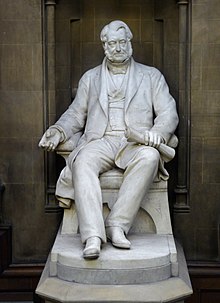Nicholas Wood
Nicholas Wood ( April 24, 1795 - December 19, 1865 ) was an English steam locomotive engineer.
Life
From 1811 he worked at the Killingworth Colliery coal mine and helped George Stephenson in the workshop behind the Dial Cottage with the development of his safety lamp for miners and in 1814 with the steam locomotive My Lord (later Blücher ) based on the model of John Blenkinsop's machine. At that time, as a result of the war, grain prices were at their highest level and therefore steam engines were cheaper than horses. In 1818 he carried out a series of experiments on rolling resistance and the like. In 1823, Wood arranged a meeting between Stephenson and Edward Pease .
With his analysis of various types of drive, which he reported on in 1825, he gained a great reputation. In 1832 he was involved in the construction of the Newcastle and Carlisle Railway and from 1845 he was director of the Newcastle and Berwick Railway .
After a mining accident in St. Hilda's Colliery, South Shields, in which 50 workers died, he co-founded the North of England Institute of Mining and Mechanical Engineers in 1852 , of which he was president for his entire life.
Fonts
- A Practical Treatise on Rail-roads and Interior Communication in General . London: Knight & Lacey, 1825. ( Online )
Web links
- Nicholas Wood, biography
- Literature by and about Nicholas Wood in the catalog of the German National Library
| personal data | |
|---|---|
| SURNAME | Wood, Nicholas |
| BRIEF DESCRIPTION | English steam locomotive engineer |
| DATE OF BIRTH | April 24, 1795 |
| DATE OF DEATH | December 19, 1865 |

